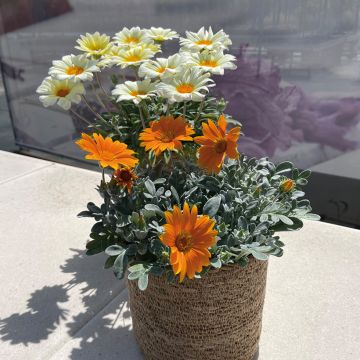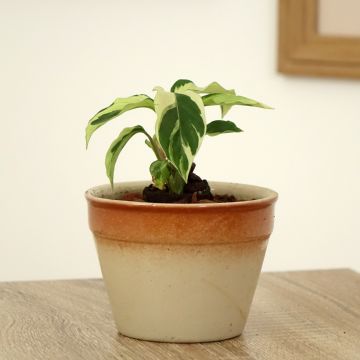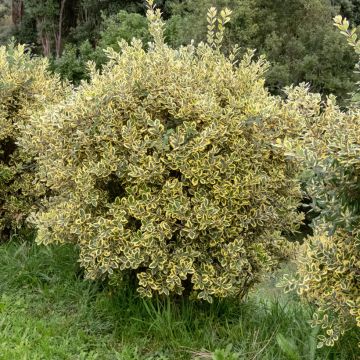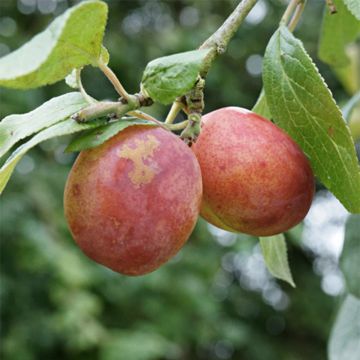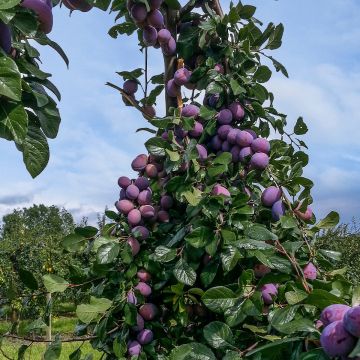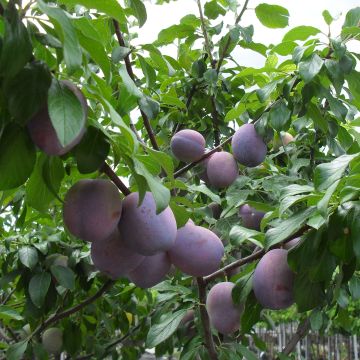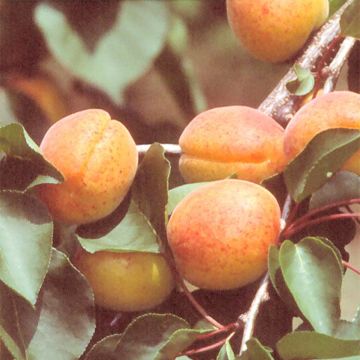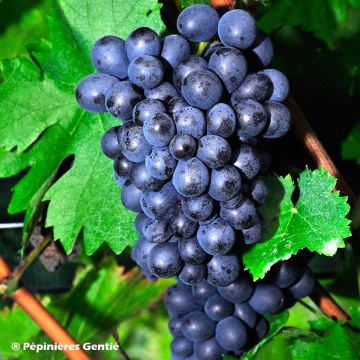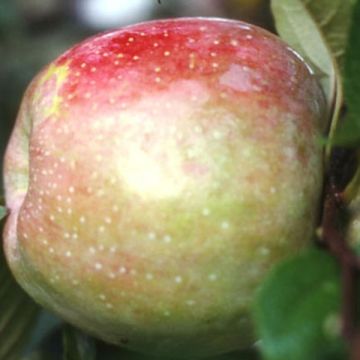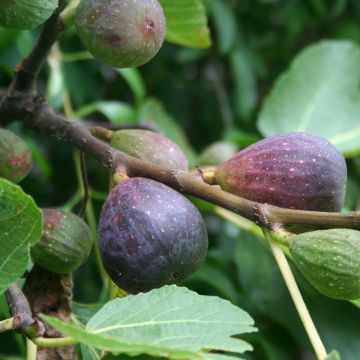

Prunier Mr Hâtif Bio en racines nues, forme scion
Prunus domestica Mr Hâtif - Organic Common plum
Prunus domestica Mr Hâtif
European plum, Common plum, Garden plum
Why not try an alternative variety in stock?
View all →This plant carries a 6 months recovery warranty
More information
We guarantee the quality of our plants for a full growing cycle, and will replace at our expense any plant that fails to recover under normal climatic and planting conditions.
Oversize package: home delivery by special carrier from €6.90 per order..
Express home delivery from €8.90.
Description
The Organic Mr Hâtif Plum Tree, from Organic farming, is a very old, vigorous, early variety, whose productivity is good but somewhat irregular. It produces dark red-violet skinned, medium-sized, round plums from the end of July, depending on the region. They have juicy and fragrant golden yellow flesh, but are not very sweet and easily detach from the stone. These fruits are perfect for pies and desserts, compotes and preserves.
The original area of plum trees, in Latin Prunus domestica, is Syria, not China. During the time of Roman rule, various local fruits including plums were introduced to Rome. The Mr Hâtif Plum Tree is also known by various regional names such as Monsieur du roi, Early Orléans, Altesse du roi. Its origin is unknown.
This fruit tree naturally grows up to 4m (13ft) high when mature, on average 3.75m (12ft). The bushy silhouette of its spreading habit is attractive and, when pruned well, it will be easy to harvest. It enjoys sun or partial shade, sheltered from the wind and grows in all types of deep soil, even clayey and fairly dry in summer. Soils that are too wet or excessively chalky should be avoided.
Its leaves are ovate, almost oblong, serrated-toothed and slightly hairy. They turn yellow in autumn before falling.
Flowering occurs early in March or April depending on the region when the tree is covered in white flowers on the previous year's branches. They are only partially self-fertile, so it is necessary to have another plum tree nearby with simultaneous flowering. The varieties 'Reine Claude d'Oullins', 'Opal' and 'Queen Victoria', or the Prune d'Ente (prune) are the most suitable. Harvesting can begin around July 15 in the hottest regions, and before August 15 in average climates.
The plums are ovoid to rounded, intense purple spotted with yellow, partly covered with a bluish bloom. Their yellow flesh is melting and juicy, with a fine and aromatic flavour. The stone does not cling to the flesh when the fruit is ripe.
Plums can be eaten raw straight from the tree, in fruit salads, desserts, or pastries and as accompaniments to meat dishes. They are transformed into jams but also into syruped fruits, compotes... They can also be used to make brandy.
For transport reasons, our tallest scions may be pruned before shipment. They are suitable for all common training sizes: cordons, espaliers, goblets, half-standards and low standards, but not high standards. If you would like more information or advice on training your fruit trees, please do not hesitate to contact us.
Prunus domestica Mr Hâtif - Organic Common plum in pictures


Plant habit
Fruit
Flowering
Foliage
Botanical data
Prunus
domestica
Mr Hâtif
Rosaceae
European plum, Common plum, Garden plum
Cultivar or hybrid
Other Plum Trees
View all →Planting and care
The Mr Hatif Plum Tree is easy to grow and undemanding, it will thrive in any type of deep and well-worked soil, moist but not excessively wet and without excessive limestone. In very clayey and compact soils, add some compost and improve drainage of the planting hole with a thin layer of gravel. Dig a hole two to three weeks before planting, twice as wide and deep as the pot. On the day of planting, place the tree with its pot in water, to wet the entire root ball. Add compost to the bottom of the hole. Install the tree in the hole and backfill with a mixture of soil and compost. Do not bury the graft union. Firm down the soil around the base. The root ball should be completely covered. Water generously.
In winter, you can apply well-rotted compost and a small handful of wood ash, rich in potash, to improve fruiting.
Planting period
Intended location
Care
Planting & care advice
This item has not been reviewed yet - be the first to leave a review about it.
Ancient and local varieties
Haven't found what you were looking for?
Hardiness is the lowest winter temperature a plant can endure without suffering serious damage or even dying. However, hardiness is affected by location (a sheltered area, such as a patio), protection (winter cover) and soil type (hardiness is improved by well-drained soil).

Photo Sharing Terms & Conditions
In order to encourage gardeners to interact and share their experiences, Promesse de fleurs offers various media enabling content to be uploaded onto its Site - in particular via the ‘Photo sharing’ module.
The User agrees to refrain from:
- Posting any content that is illegal, prejudicial, insulting, racist, inciteful to hatred, revisionist, contrary to public decency, that infringes on privacy or on the privacy rights of third parties, in particular the publicity rights of persons and goods, intellectual property rights, or the right to privacy.
- Submitting content on behalf of a third party;
- Impersonate the identity of a third party and/or publish any personal information about a third party;
In general, the User undertakes to refrain from any unethical behaviour.
All Content (in particular text, comments, files, images, photos, videos, creative works, etc.), which may be subject to property or intellectual property rights, image or other private rights, shall remain the property of the User, subject to the limited rights granted by the terms of the licence granted by Promesse de fleurs as stated below. Users are at liberty to publish or not to publish such Content on the Site, notably via the ‘Photo Sharing’ facility, and accept that this Content shall be made public and freely accessible, notably on the Internet.
Users further acknowledge, undertake to have ,and guarantee that they hold all necessary rights and permissions to publish such material on the Site, in particular with regard to the legislation in force pertaining to any privacy, property, intellectual property, image, or contractual rights, or rights of any other nature. By publishing such Content on the Site, Users acknowledge accepting full liability as publishers of the Content within the meaning of the law, and grant Promesse de fleurs, free of charge, an inclusive, worldwide licence for the said Content for the entire duration of its publication, including all reproduction, representation, up/downloading, displaying, performing, transmission, and storage rights.
Users also grant permission for their name to be linked to the Content and accept that this link may not always be made available.
By engaging in posting material, Users consent to their Content becoming automatically accessible on the Internet, in particular on other sites and/or blogs and/or web pages of the Promesse de fleurs site, including in particular social pages and the Promesse de fleurs catalogue.
Users may secure the removal of entrusted content free of charge by issuing a simple request via our contact form.


































